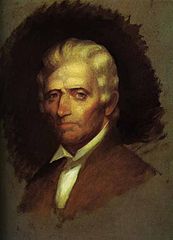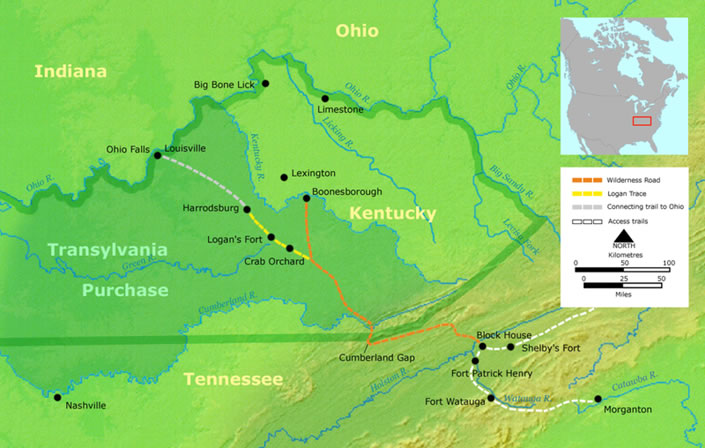This Week in History
November 4 - 10, 1734
Daniel Boone: Leading American Settlements Westward
from the Ohio to the Missouri
November 2012

|
Oil sketch of Daniel Boone by Chester Harding, the only portrait of Boone painted from life. This was painted when Boone was 84 years old, a few months before his death. Harding painted Boone in June 1820 while Boone was living with his daughter Jemima Boone Callaway in Missouri. According to historian Ted Franklin Belue, "from this original oil portrait Harding made three copies: two busts and a full-length." (The Life of Daniel Boone by Lyman Draper, edited by Ted Franklin Belue. Mechanicsburg, PA: Stackpole Books, 1998, p. 2.)
|
In 1784, taking advantage of the brief pause in Indian raids on Kentucky, an early chronicler of the West named John Filson asked Daniel Boone to tell him the story of his exciting life. The result, published as Boone's "Autobiography," made Daniel Boone famous both in the new United States and in Europe. But the legends that grew out of the book pictured Boone as a solitary explorer and hunter who never saw a town, turning his back on civilization and fleeing before its spreading tide. In reality, Boone was dedicated to helping his fellow man, and played an important role in bringing settlers and republican government to the lands beyond the eastern mountains.
Daniel Boone was born on Nov. 2, 1734, on what was then the Pennsylvania frontier, near the present site of Reading. His family were Quakers, and, in addition to farming, his father followed the trades of weaver and blacksmith, which he also taught to Daniel. Even as a boy, Daniel hunted for his family and brought the pelts to Philadelphia to exchange for the necessities of life. Although there were no schools in his area, Daniel's older brother married a well-educated woman who taught Daniel reading, writing, and arithmetic. He then continued to read on his own, and taught himself surveying.
In 1750, Daniel's parents moved the family to the Yadkin Valley in western North Carolina. In that year, the French were moving down from Canada to bury lead plates in the Ohio Valley, claiming it for France. A series of French Forts were built from the Great Lakes to the Mississippi, and when Virginia's governor sent George Washington to challenge these advances, one of the French Indian agents sent a Indian brave on an unsuccessful mission to assassinate the young messenger.
An American attempt to plant a settlement near the future Pittsburgh, and thus open the way to American settlement of the Ohio Valley, led to a military battle where George Washington was defeated by a superior French force. This conflict in the wilderness forced the British government to send Gen. Edward Braddock, in 1755, to evict the French from Fort Duquesne at the forks of the Ohio. That year, Daniel Boone joined a unit of 100 North Carolina frontiersman and acted as their wagoner and blacksmith as they travelled north to take part in Braddock's expedition. There, Boone made the acquaintance of young George Washington as well as Daniel Morgan, another wagoner who was to become a general during the American Revolution. During the terrible massacre of Braddock's defeat, Boone and Morgan were able to escape by cutting the traces of their teams and mounting one of their horses.
|
Cumberland Gap and Wilderness Road
|
During that expedition, Boone also met John Finley, who had earlier explored Kentucky to the Falls of the Ohio, the location of present-day Louisville. Finley told Boone about the fertile soil and abundant game, and Boone became eager to see it. At various times, Kentucky had been claimed by the Shawnee, the Iroquois, and the Cherokee, but it remained as a wilderness, crossed by Indian trails used for hunting or for attacking enemy tribes. But to the Americans, Kentucky was an important flank; it was positioned so that American settlers there could attack the Indian villages of the Ohio Valley if the French, or later the British, hurled their Indian allies against the colonies.
After Braddock's defeat Boone returned to the Yadkin Valley, married, and started a family. But in 1759, the Cherokees raided the valley and the Boones were scattered. Daniel and his family went to Culpeper County in Virginia, and Daniel made frequent trips to Fredericksburg, the town where George Washington's mother and younger brothers and sisters lived, and which Washington often visited. When the Boones returned to the Yadkin, Daniel was more than ever determined to reach Kentucky.
In 1767, Boone and his party of frontiersmen explored the southern part of the Big Sandy River and reached eastern Kentucky. At the same time, George Washington was making the first surveys on the northern parts of the Little and Big Sandy Rivers. The next year, when John Finley accompanied Boone through the Cumberland Gap to Kentucky, Washington was surveying tracts along the Ohio River and the Great Kanawha, planning for a large settlement on lands which had been granted to him and other soldiers for their service during the French & Indian War.
After several hunting and surveying trips to Kentucky, during which he often read Jonathan Swift's Gulliver's Travels aloud to his companions, Boone became the right-hand man to Richard Henderson, a respected North Carolina judge. On the basis of Boone's descriptions of Kentucky, Henderson founded the Transylvania Company, which aimed to establish a new American colony in the wilderness. Henderson bought land from the Cherokee nation, and Boone led a party of thirty backwoodsmen to mark the path to the Kentucky River, where the capital of the new colony would be established. The new town was named Boonesborough, and Boone used his surveying skills to lay out the town in two-acre lots.
Daniel and his brother were two of the 18 delegates who voted at the convention called to establish a form of government and elect officers. The compact provided for "perfect religious freedom and general toleration," and set up a judicial system and the regulations for a militia. But shortly afterward the American Revolution began, and all proprietary colonies were declared invalid. Kentucky became a county of Virginia on December 31, 1776. A good beginning had been made, however; over 900 entries had been registered in the land office at Boonesborough. And 230 acres of corn had been raised, a stock of horses, hogs and poultry had been introduced, and apple and peach trees had already been planted in Kentucky.
The British realized the danger American possession of Kentucky posed to their Indian allies, and to the British forts on the Great Lakes and in the Ohio Valley. They incited the Indians to attack the American settlers, and provided them with leaders from among the French Canadian agents who had previously led the Indians for the French. The Kentucky settlers consolidated into a few fortified towns, and resisted savage attacks all through the Revolution. In 1777, Boone and his salt-making party were captured by the Shawnee and taken to Ohio. He was adopted by Chief Blackfish and then taken to Detroit to British Gen. Henry Hamilton, dubbed "The Hairbuyer" by the Americans because he paid for American scalps.
Boone pretended to favor the British, but at a moment when the Indians were distracted by a huge flight of wild turkeys, he made his escape and travelled 160 miles in four days to organize the defense of Boonesborough. After beating off the Shawnee attack, Boone returned across the mountains to retrieve his family, who had left because they thought him dead. On the return trip he brought many new settlers, among whom was Abraham Lincoln, the grandfather of the future President. The Boones and Lincolns had been close friends and neighbors in Pennsylvania, and the two families had often intermarried.
Boone then moved his family to Fayette County in Kentucky, where he was elected lieutenant colonel of the militia, under Col. John Todd, of the family of Mary Todd Lincoln. In April of 1781, Boone was sent to Richmond as one of the first representatives of Kentucky's Fayette County in the Virginia State Legislature. When Col. Banastre Tarleton of the British Army made a lightning raid on Charlottesville, Boone and other legislators were captured. They were taken to the camp of General Cornwallis, but released after a few days of captivity.
After the Revolution, Boone moved his family to Maysville on the Ohio River. There, he made surveys and ran a small store where he sold goods useful for the newly arriving settlers. The citizens of Maysville also elected him to the Virginia legislature, where he worked tirelessly to obtain military supplies for the frontier, which was still being attacked by Indians deployed out of British-occupied Detroit. But during the years 1785-1798, Boone gradually lost all his claims to land in Kentucky, due to problems in how they were registered.
As a result, in 1788, he moved his family to the junction of the Great Kanawha and Ohio Rivers, now in West Virginia, and the very place where George Washington and his fellow veterans had planned for a settlement. Again, the citizens elected him to the Virginia legislature, and he also served as a deputy surveyor and lieutenant colonel of the Kanawha County Militia. But in 1796, Boone's son Daniel Morgan, named after his old friend in the Braddock expedition, moved to eastern Missouri to take advantage of Spanish offers of land for settlers. Three years later, Daniel Boone and his wife and younger children followed him to the Femme Osage valley, six miles from the Missouri River and 45 miles by water from St. Louis.
The governor appointed Boone a Syndic for the Femme Osage region, which meant he was a magistrate with the powers of a sheriff and judge. He held this post until the Louisiana Purchase ceded the area to the United States. In 1804 Meriwether Lewis and William Clark visited Boone before embarking on their expedition, gathering valuable information about the lands to the west, which Boone had not been able to resist exploring.
Daniel Boone also made long hunting and scouting trips into Kansas, and in 1814, at the age of 80, he and a small party reached the Yellowstone River. Another member of his family did succeed in Boone's ultimate quest, but Boone knew that he himself could not travel that far, so he had to be content with seeking all the information he could about California. His son Daniel Morgan became the first settler in Kansas, and one of his grandsons was an early settler of Colorado. Boone's relative Kit Carson upheld Daniel's dream by reaching California and Oregon as the scout for John C. Fremont's western expedition.
Due to problems in registering his land deeds, Daniel Boone almost lost his Missouri land. But in replying to his petition, and the supporting petition of the Kentucky Legislature, the U.S. Congress, in 1810, confirmed Daniel Boone's Spanish grant with words of praise for "the man who has opened the way to millions of his fellow men."
The original article was published in the EIR Online’s Electronic Intelligence Weekly, as part of an ongoing series on history, with a special emphasis on American history. We are reprinting and updating these articles now to assist our readers in understanding of the American System of Economy.

